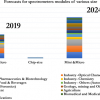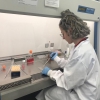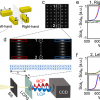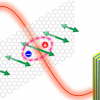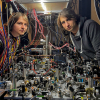There are many processes, such as propulsion, in which fluid in a supercritical state, where the temperature and pressure put a substance beyond a distinguishable liquid or gas phase, is injected in an environment of supercritical thermodynamic conditions. Under these conditions, mixing and interaction dynamics do not behave as they would in their well-defined liquid or gas phases. Rocket engines, gas turbines and diesel engines experience conditions in their combustion chamber that exceed the critical conditions of their fuel, and supercritical finely atomised sprays are used to coat tablets in the production of medicines. In both cases, understanding the precise dynamics of how the fluid breaks up and disperses can lead to fundamental improvements in the ways such systems are built.
The study of jet disintegration focuses in particular on fuel breakup and mixing within the combustion chamber of propulsion devices. A team of researchers at the University of Florida applied spectroscopic diagnostics techniques to learn more about the fundamentals of sub- and supercritical jet disintegration, and reported their new findings in Physics of Fluids.
“The Planar Laser Induced Fluorescence (PLIF) technique and the process of correcting for absorption effects is a tool that is unique to the Combustion and Propulsion Laboratory”, said Shaun DeSouza, a researcher at the University of Florida and lead author of the publication. “This method provides quantitative data for comparison with the qualitative data produced by the shadowgraph technique.” While imaging studies of jets have been performed by many different research institutions, there is limited quantitative density data reported in these studies.
To get that quantitative data, DeSouza and his collaborator ran 48 tests of jets injected from a single orifice into a chamber with one of a range of sub- to supercritical temperature and pressure combinations. They used the fluid fluoroketone in these tests because of its low critical temperature and pressure, characteristics governing the supercritical behaviour of interest, as well as its distinct spectral features well suited to PLIF detection.
The results of the study demonstrated the accuracy of PLIF, imaging single planes of the flow field through the centre of the jet, leading to noticeable differences in the measured spreading angle compared to shadowgraphy. Unlike shadowgraphy, which integratively images the entire jet, PLIF provides more detailed density information that illuminates features shadowgraphy cannot detect.
Each imaging technique offers complementary advantages, with PLIF providing quantitative density results and shadowgraphy providing very detailed flow visualisation. While the shadowgraph data agreed with previous visualisation studies, the PLIF results that provided quantitative measurement of central jet plane density and density gradients offered new and differing results.
The results also revealed trends key to understanding and improving applications like jet propulsion, such as an increase in normalised drop diameter and a decrease in droplet population as chamber temperatures increased. According to the work, however, both droplet size and distribution were independent of chamber pressure.
“The next step for this line of research is to expand the thermodynamic conditions explored and to improve imaging hardware to gain a better understanding under a larger variety of conditions”, said DeSouza.








